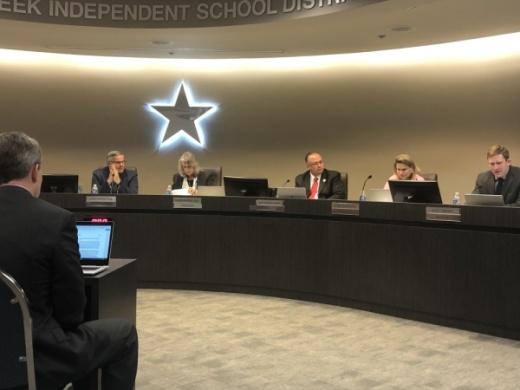Clear Creek ISD’s board of trustees approved $2 million in state funding to provide resources for students in a variety of English Language Arts and English as a Second Language classrooms at the Feb. 24 regular meeting.
Several subject area subcommittees completed the process of reviewing and selecting instructional resources. The subcommittees were made up of teachers—including representatives from English as a Second Language, special education, and technology—and a parent or community representative per committee. Resources were selected for English Language Arts and Reading, grades 9 to 12; English Language Arts Electives; English Learners Language Arts, seventh and eighth grades; and English I and II for Speakers of Other Languages.
Steven Ebell, deputy superintendent of curriculum and instruction, said during the meeting that the process of reviewing and selecting resources in this manner is deeply ingrained in the history of CCISD. The selection of subcommittee members and implementation of their duties took place throughout the fall, said Ebell and Susan Silva, the executive director of curriculum and instruction.
The criteria for evaluating resources included alignment to the district’s curriculum and philosophy as well as flexibility of implementation. Some of the recommended English Language Arts materials include books for classroom libraries across various genres and accessibility levels, subscriptions to Scholastic magazines and subscriptions to contemporary plays via an online database, as well as course-specific technology, equipment and instructional materials for advanced placement courses and electives.
“That whole area is just concerning to me,” she said. “Are children getting the same experience because of different books being read?”
Anthologies and educational class sets would be the same across all grade levels, Ebell and Silva said in response.
“There really is a wide variety of literature and accessibility in all these classroom libraries,” Ebell said.The classroom libraries and their structure are a result of the district’s strategic plan, district officials said. The process of letting students pick books themselves allows them to independently practice the skills required to read the text, as opposed to measuring those same skills with a classwide book that individual students may not be as interested in, Ebell and Silva said.
CCISD officials told Community Impact Newspaper in November that the 2020-25 strategic plan would go before the board for approval at the Feb. 24 meeting. No plan was brought forward at the meeting, and, as of Feb. 24, the most current plan is still in draft form.
The subcommittees recommended the use of curriculum-building tool StudySync for English language learner students. ELL skill lessons with StudySync emphasize explicit vocabulary instruction, language acquisition and reading comprehension, according to the StudySync website.
The subcommittees will provide the Texas Education Agency’s Instructional Materials Allotment Committee with their recommendations, and the district will initiate negotiations with selected vendors now that the board has approved the resource selections. The vendor selection will go before the board for approval next month.The board also recommended the approval of Liliana Martinez for the elementary Spanish language arts and social studies coordinator position during the meeting.
“We’re excited to have Ms. Martinez on board in that capacity,” CCISD Superintendent Greg Smith said.
Nearly 2,000 students in CCISD are bilingual, according to TEA data. Seven CCISD campuses offer dual-language programs, and ESL is available in elementary, middle and high schools.
Editor's note: The story has been updated to reflect that Clear Creek ISD's dual-language program and English as a Second Language (ESL) program are separate. The resources that were voted on are for the curriculum for the ESL program.





